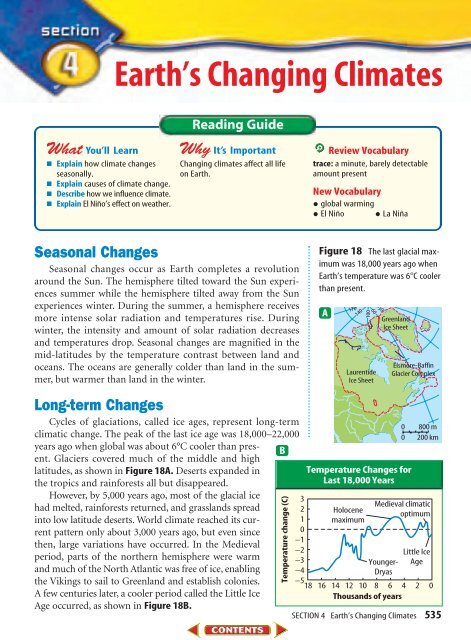CHAPTER 17 Weather and Climate - Mr. Barrow's Science Center
CHAPTER 17 Weather and Climate - Mr. Barrow's Science Center
CHAPTER 17 Weather and Climate - Mr. Barrow's Science Center
Create successful ePaper yourself
Turn your PDF publications into a flip-book with our unique Google optimized e-Paper software.
Earth’s Changing <strong>Climate</strong>sReading Guide■ Explain how climate changesseasonally.■ Explain causes of climate change.■ Describe how we influence climate.■ Explain El Niño’s effect on weather.Changing climates affect all lifeon Earth.Review Vocabularytrace: a minute, barely detectableamount presentNew Vocabulary•global warmingEl NiñoLa Niña•Seasonal ChangesSeasonal changes occur as Earth completes a revolutionaround the Sun. The hemisphere tilted toward the Sun experiencessummer while the hemisphere tilted away from the Sunexperiences winter. During the summer, a hemisphere receivesmore intense solar radiation <strong>and</strong> temperatures rise. Duringwinter, the intensity <strong>and</strong> amount of solar radiation decreases<strong>and</strong> temperatures drop. Seasonal changes are magnified in themid-latitudes by the temperature contrast between l<strong>and</strong> <strong>and</strong>oceans. The oceans are generally colder than l<strong>and</strong> in the summer,but warmer than l<strong>and</strong> in the winter.Long-term ChangesCycles of glaciations, called ice ages, represent long-termclimatic change. The peak of the last ice age was 18,000–22,000years ago when global was about 6°C cooler than present.Glaciers covered much of the middle <strong>and</strong> highlatitudes, as shown in Figure 18A. Deserts exp<strong>and</strong>ed inthe tropics <strong>and</strong> rainforests all but disappeared.However, by 5,000 years ago, most of the glacial icehad melted, rainforests returned, <strong>and</strong> grassl<strong>and</strong>s spreadinto low latitude deserts. World climate reached its currentpattern only about 3,000 years ago, but even sincethen, large variations have occurred. In the Medievalperiod, parts of the northern hemisphere were warm<strong>and</strong> much of the North Atlantic was free of ice, enablingthe Vikings to sail to Greenl<strong>and</strong> <strong>and</strong> establish colonies.A few centuries later, a cooler period called the Little IceAge occurred, as shown in Figure 18B.Temperature change (C)Figure 18 The last glacial maximumwas 18,000 years ago whenEarth’s temperature was 6°C coolerthan present.Temperature Changes forLast 18,000 Years3Medieval climatic2 Holoceneoptimum1 maximum0–1–2Little Ice–3Younger- Age–4Dryas–5 18 16 14 12 10 8 6 4 2 0Thous<strong>and</strong>s of yearsSECTION 4 Earth’s Changing <strong>Climate</strong>s 535


